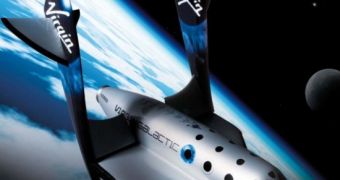The National Oceanic and Atmospheric Administration (NOAA) has signed a collaboration agreement with space craft developer Virgin Galactic (VG) to facilitate its studies of the climate changes on our planet. NOAA monitoring equipment will be placed on board of all VG aircrafts that will be performing orbital flights with civilian passengers. Since NASA will be crippled between 2010 and 2015, due to the fact that the shuttle program will be closed, all institutions dependent on its services will now have to turn to the private sector for assistance.
Measurements will be conducted just outside the atmosphere, in a very low orbit. VG crafts are capable of exiting the atmosphere for short periods of time, carrying 6 passengers and 2 crew members. If the agreement is put into action, all VG flights will also perform automated observations of carbon emissions, as well as of the development of tropical storms and other unusual atmospheric activities. Both parties involved aim at getting a better understanding of the way greenhouse gases affect the chemical composition of the air, in an attempt to try to predict future changes.
Gathering air samples will also be a top priority for these missions, as constant analysis of its composition may offer scientists new ways of looking at global warming and the effect man-made activities has on it. VG's goal is to start taking people into space once per week at first, and then to climb up to one or two flights a day. Such flight density will provide NOAA with an almost constant stream of data related to the atmosphere and the changes it undergoes in real-time.
Another thing these new ships do is offer previously impossible access to suborbital and high altitude areas of the atmosphere, which are out of range for both airplanes and satellites. These areas are vital to understanding the complicated processes that regulate Earth's atmosphere. The spacecrafts will also be able to provide better satellite calibration standards for measuring gases and carbon emissions in the upper layers of the atmosphere.

 14 DAY TRIAL //
14 DAY TRIAL //